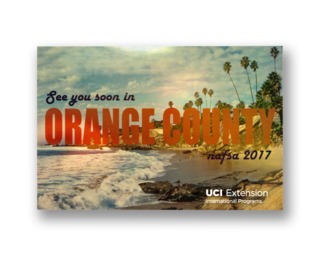allura printing: Aiming to be SoCal's Printing Leader
"Our clients are loyal to us because we treat them well, and we're here when they need us. This is why we're successful.”

Brothers David and Renee Gagnon grew up in printing in Quebec, Canada. But when it came time to open their own printing business, they chose Costa Mesa, California.
Was the move predicated on a more favorable printing market, greater access to a highly-skilled pool of labor or even on a more inviting climate? “No, it was love, the love of a girl,” says David Gagnon. Both Canadian brothers married Mexican women. One might say they met their wives more than half way by resettling in Orange County.
The company these second-generation printers founded, allura printing Inc., recently celebrated its 10th anniversary. Offset printing represents about 60 percent of the company's business; digital printing comprises the remainder.
“A big percentage of our revenues comes from book printing, the remainder from commercial work,” Gagnon says. In the book printing side of the business, he adds, “we serve traditional publishing houses, independent publishing houses and we do business directly with authors interested in self-publishing.”
The printing of books is a passion at allura, so much so that its employees wear white gloves when handling the book covers it prints. It can manage the entire book printing process for clients, regardless of whether the size of the project is 10 books or 100,000. The company is a specialist in flexible short-run and print-on-demand services.
It encourages its clients to keep inventories low by printing small quantities of books and regularly testing the market for those books. This approach, allura reminds its clients, enables them to save warehouse space and costs, and reduce cash flow impact.
A substantial part of its book-printing business is undertaken on behalf of self-published authors, including professionals, business people, thought leaders, and independent writers who want to impart their messages through high-quality, soft cover, and perfect-bound books. This segment of allura’s business has benefited from its willingness to guide self-published authors through the process, helping them grasp not only whether long or short runs make more sense, but also the variability possible regarding the appearance and feel of their books.
Offset and digital
allura printing’s offset output includes direct marketing, letterhead, stationery, and collateral materials. Specific pieces include postcards, brochures, direct mail, flyers, manuals, business cards, and envelopes. Among the customers for its offset printing are a broad variety of businesses and brands, including University of California-Irvine, CommerceWest Bank, and Moran and Company. Its offset printing capabilities include a wide array of services.
In prepress, allura can offer file preflight, preparation and proofing, and its new state-of-the-art computer-to-plate system. The company invested in the system to take plating in-house for enhanced management and efficiencies. Bindery services include trimming, folding, and scoring. And fulfillment services include handling, mailing, and distribution.
“As for our commercial work, we do business with vice presidents of marketing for corporations, advertising agencies, manufacturers, and the healthcare industry,” Gagnon says.
Direct mail and collateral materials make up much of allura's commercial work. The shop turns out direct mail pieces, postcards, brochures, flyers, sell sheets, manuals, booklets, business cards, and pull-up banners, to name a few. Large-format printing of banners and signs is a specialty and a growth opportunity for the shop. Its digital printing services include prepress, bindery, fulfillment, variable data printing, and print on demand.
California Pacific Homes, the Garden Grove School District, and The CORE Institute make up a representative sample of the company's commercial and institutional clients.
What came first?
By the time they came of age in their father's Forestville, Québec, Canada shop, the Gagnon brothers had developed “an offset background,” says David Gagnon. They had grown up on lithographic printing and honed their craft on a Heidelberg Windmill press. But before launching allura in 2006, they analyzed the market and available technology, and embraced digital printing. “We started off with an HP Indigo press. But we also had a small offset machine, so you could say both digital and offset were part of our operation from the start.”
The book business represented a logical early step forward for allura in 2008. “We always thought books were a good area to go into,” Gagnon says. “Being from Québec, Canada, that is a natural because the region is a huge book-producing region. My brother Renee has worked for a big company, Transcontinental Group, which is a major book printer.”
However, substantial upfront effort was required to market their wares. The brothers intensively tackled the market, steadily building share over time. “We did several things,” Gagnon recalls. “We put a lot of effort into the sales force, and we undertook cold calling and direct mail campaigns, the traditional ways to build and market a book printing business.”
Offset with a difference
Just recently, the Gagnons purchased a Heidelberg Speedmaster SM52 with Anicolor inking technology, the number 52 referring to 52 centimeters or about 20 inches.
The investment was significant in that it meant acquiring not just the press itself, but also a larger print shop that could accommodate the press. allura recently moved into this new, larger facility. The brothers are betting on a robust market for their printing, a market to be handled by both their new shop’s size and their new press’s capability.
This is a press that responds to today's smaller print runs by starting to pay for itself with the first job. “The reason we purchased the machine is it's not a conventional offset press; it has a new inking technology,” Gagnon says. “Heidelberg came out with this in the mid-2000s. It's been out there for 10 years. We're the first commercial printing operation in Southern California to have this technology. It's very popular in Africa, Europe, and Russia, but here in the U.S. there are only about 30 of these machines in the nation.”
The inking unit makes the printing process more efficient, he adds. With fewer inking rollers, set-up can be complete in 6 as opposed to 20 to 25 minutes. Only 15 sheets need be consumed setting up the colors, in stark contrast to several hundred sheets on older offset presses. “This technology is not only good for efficiency, but good for the environment and it costs you less,” Gagnon says. “The initial cost is not more than traditional offset machines.”
Because many fewer sheets are used, the Gagnons can be more competitive on price and more efficient as well, allowing them to compete very well against conventional offset.
allura can win contracts that would normally have to be produced on digital. “But I can do it on offset, with all the benefits of an offset press, which includes speed – 15,000 sheets an hour – and I can coat my jobs and produce outstanding offset quality,” Gagnon says.
What's more, the learning curve required to “master the Speedmaster” was not as steep. “It was smoother because we do have the offset background,” Gagnon says.
“What really caught our attention was Heidelberg Anicolor technology. Since the speed is much higher than what we were used to before, we can increase our production capabilities so we can produce more and generate increased revenues.”
Keys to success
The success of allura printing has been founded on bedrock principles that have underpinned the mercantile triumphs of many other companies in varied fields throughout history. “We believe in professionalism, integrity and customer service,” Gagnon says.
“I believe our clients are loyal to us because we treat them well, and we're here when they need us. This is why we're successful and have a good reputation.”
You might assume such a track record would leave David or Renee Gagnon inclined to dispense advice to other shops, particularly those looking to leverage offset capabilities.
“Not really,” observes David Gagnon. "The reason I say that is because every shop is different. allura has a personality, our own DNA and a very specific market. There's no other allura out there. My neighbor may be specializing in something else. I can't say everyone should get the Anicolor technology, because it might not be appropriate for them. But it was for us. The only advice I would have is take the time and do your research before investing in your business.”
While David and Renee may eventually explore other technologies, they are currently laser focused on leveraging the Heidelberg's capabilities to the fullest extent. One area of particular promise is the packaging industry, Gagnon says. “That machine has a special feature that allows you to run a very thick, up to 24-point cardboard. A lot of other companies do not have the capability to print on that thickness. Those that do are in packaging.”
When it comes to setting their sights on a goal, the brothers have not hesitated to establish lofty objectives. “Our aspiration,” Gagnon says simply, “Is to become the leader in the printing industry in Southern California.”


